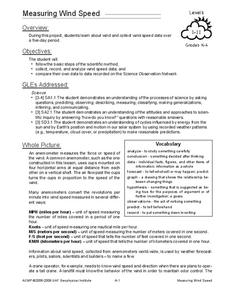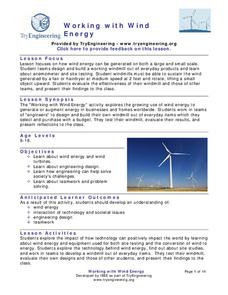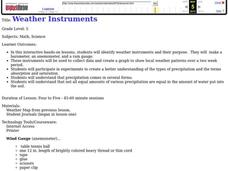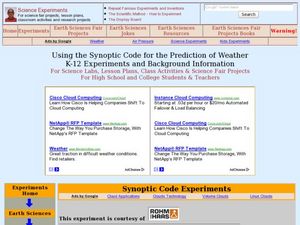Curated OER
TE Activity: Build an Anemometer
Students determine what an anemometer is and how it measures wind speed. They decide on a place to put a wind turbine by using an anemometer. They examine the role that engineers play when using wind speed to determine a place for wind...
Curated OER
Measuring Wind Speed
Students study wind speed and collect wind speed data. In this wind speed lesson, students visit a website to learn about the local wind speed forecast for their week. Students discuss wind and wind speed. Students collect wind speed...
PBS
Twirling in the Breeze
Blow classes away with a hands-on lesson investigating wind speed. Learners use common materials to design and construct anemometers. They then test their anemometers and collect data on the wind speed created by a fan.
Curated OER
Build an Anemometer
Students investigate wind speed. In this wind instrument activity, students build an anemometer to measure wind speed and discuss the importance of wind speed knowledge in various professions.
Curated OER
Wind
Young scholars build an anemometer and measure wind speed. In this wind speed lesson plan, students build an anemometer using the student instruction sheet. Young scholars visit the Alaska windspeed website and look up the wind speed...
Curated OER
Wind
Students conduct an experiment. For this wind measurement lesson, students learn about instruments that measure the wind and then make a weather vane. Students record wind speed over a few days.
Institute of Electrical and Electronics Engineers
Working with Wind Energy
After reading about how wind turbines work to collect clean energy, groups brainstorm and design their own windmill. Within the provided financial and physical constraints, groups must build a working windmill using only the materials...
Curated OER
Making An Anemometer
Students discover how to capture the speed of wind. In this science activity instructional activity, students gather materials and follow procedures to create an anemometer to measure wind speed.
Curated OER
Who Has Seen the Wind?
Students investigate the characteristics of wind. In this weather lesson, students use poetry and van Gogh's paintings to discuss the movement of wind. Students are introduced to the Beaufort Scale and use the tool to measure the wind...
Curated OER
Weather
Second graders study the basic components of weather. They construct a thermometer and anemometer to measure temperatures, precipitation, and wind speed. In addition, 2nd graders discover how to find these components on weather maps.
Curated OER
Weather instruments
Students explore weather instruments. In this weather lesson, students make rain gauges, anemometers, and barometers following the instructions given in the lesson. Students set up a weather station using their instruments and record and...
Curated OER
Everyone Knows It's Windy
Young scholars create an anemometer, an instrument that measures wind speed.
Curated OER
Interdisciplinary Task: Weather
Learners design a chart to use to record the weather for five days. They then build an anemometer to record wind speed and discover why they are used for this purpose.
Curated OER
Wind
Fourth graders are read a story and answer the comprehension questions about sound and wind. In groups, they make their own wind vane and how to determine the direction of the wind. To end the lesson, they make their own Anemometer to...
Curated OER
Energy Sources -- Windmill Competition Investigation
Students work together to use an anemometer to measure wind speed. They use their anemometer to complete different experiments. They work together to design their own windmill.
Curated OER
Using the Synoptic Code for the Prediction of Weather
Young scholars interpret the synoptic code. They construct a thermoscreen with an anemometer. Students identify different types of clouds and understand and read barometric pressure. Young scholars predict weather pattern as they apply...
Montana State University
What's the Weather?
How many jackets do you need to stay warm and climb Mount Everest? An informatie resource covers the topic of Mount Everest, the resource helps young scientists discover the difference between climate and weather. Activities include...
Curated OER
Weather: Piecing It All Together
Fourth graders collect, record, and analyze data using simple weather instruments and a variety of weather resources to investigate weather. They observe the teacher demonstrate how a rain gauge functions, record the weather for five...
Curated OER
Using the Synoptic Code for the Prediction of Water
Students construct a thermoscreen for the experiment. For this earth science lesson, students make observations and interpret them using synoptic codes. They predict the weather based on gathered information.
Curated OER
Weather Patterns
Students collect weather data over a thirty day period to gain an increased understanding of the weather patterns in their area. Once the data is collected, students post their finding online using a web tool. Finally, students attempt...
Curated OER
Graphing the Weather
Fourth graders predict the weather for their area using simple weather instruments. They take readings for a month during a season and graph their results. Students describe weather patterns based on their data and predict future weather...






















